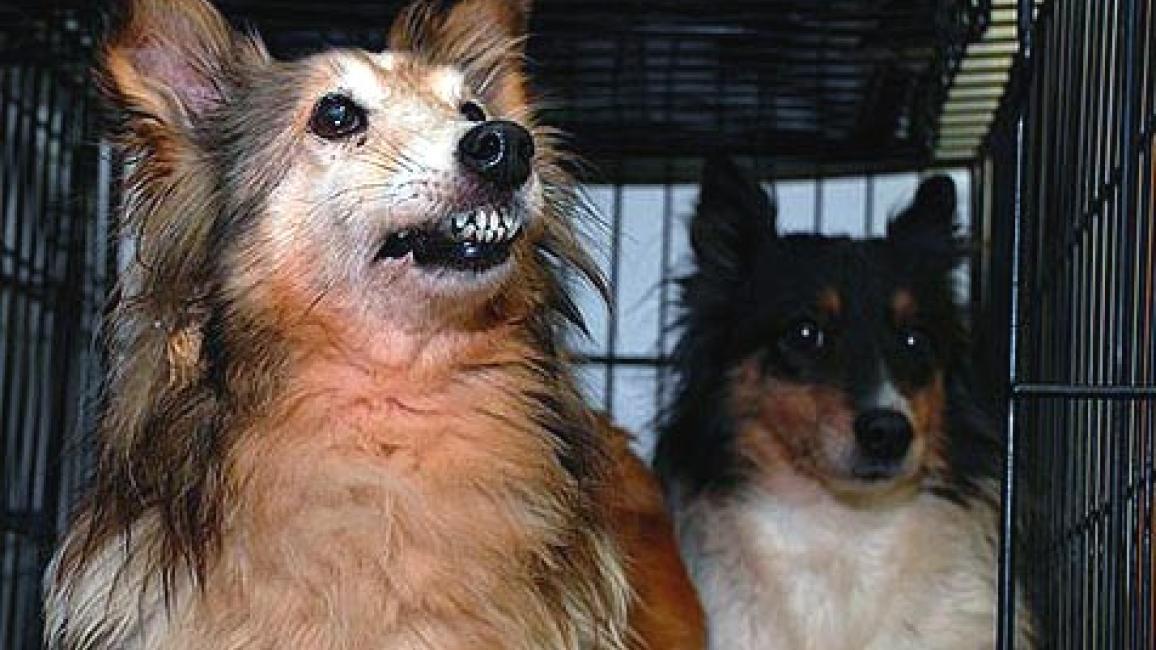The truth about the pet trade and puppy mills

For the nine-year-old sheltie, the breeders’ auction marked the end of a long and difficult road. She had lived her whole life in a dirty rabbit hutch at a puppy mill, where she was forced to have litter after litter so the people who barely did more than keep her alive could make money from her offspring.
Dog breeders' auction
Someone who attended the auction said the sheltie just stood there in her cage, her face vacant. She showed no emotion at all. Maybe that’s how she survived those horrible years – by simply shutting down.
Dr. Frank McMillan, a veterinarian with Best Friends Animal Society, has seen that vacant look before in dogs from commercial breeding facilities. He likened it to the dissociation people sometimes experience after suffering major trauma.
"Some of them are horribly damaged emotionally," he says.
Saving a sheltie dog and other dogs and puppies
The sheltie would never make it to the bidding block in the Missouri auction house. She had outlived her money-making capabilities and, for the breeders in the audience, she had no worth at all. To them, she was just a "dump dog." Chances are she would have simply been taken out and disposed of at the end of the auction. But she got lucky.
Rescuers from several animal welfare organizations, including Wasatch Animal Rescue, based in Salt Lake City, Utah, and Mill Dog Rescue Network of Colorado Springs, Colorado, organized and partially funded by Best Friends, squeezed into two vans and headed east to America’s heartland – the commercial dog-breeding mecca. The rescuers were bound for an auction house in southwest Missouri that was getting ready to hold its first big sale of the year – an event in which more than 600 dogs would be put on the block and sold to the highest bidders.
Heather, of Wasatch Animal Rescue, was at that auction. She said it broke her heart to watch the animals being carried to the auction block. "They carried these dogs like toxic waste," she says. "I carry garbage closer to my body. It showed their complete disregard for these animals."
While some dogs sell for hundreds, even thousands of dollars, others – the older breeding dogs like the sheltie and the puppies older than 10 weeks, who won’t sell well at pet stores – end up being passed over. They’d be doomed to a horrible fate if rescuers weren’t there to take them.
The rescuers were there to save lives. The breeders were there to make a profit.
Dog breeders making a profit
These auctions, which are held most every weekend during the warmer months, are for breeders to make a buck off the animals they no longer want. Perhaps they’re trying to get rid of their "dump dogs," or they have too many of a certain breed or they’ve decided to get out of the breeding business altogether.
Of the dogs sold at the Missouri auction, the highest price was $1,750 for a French bulldog. Others sold for as little as $25. At some auctions, dogs sell for practically nothing – a quarter apiece.
It’s estimated that four million dogs are bred in commercial facilities every year to be sold in pet stores, over the Internet and through newspaper classified ads. Meanwhile, three to four million pets are killed in shelters each year.
One by one, the dogs were put on the auction block as the auctioneers shouted out things like "She’s ready to go home and work for you" and "These go for $1,500 to $2,000 on the Internet" and "She’s coming into season now. Bring her home and breed her tomorrow."
Some of the dogs had missing teeth, eye infections and other ailments. But, as long as the dogs can crank out puppies, those things don’t matter to the for-profit breeders. One of the sheltie’s teeth actually fell out in her water bowl, Heather says.
A new life for a sheltie and her daughter
Today, the sheltie and her seven-year-old daughter are now healing in the loving home of Barbara Edelberg and Jim Melton, both with Sheltie Rescue of Utah.
Barbara says the older sheltie’s muzzle was so swollen with abscesses and infection that her veterinarian cleared her schedule to perform an emergency dental. Since the sheltie and her daughter had never been separated their entire lives, they made sure her daughter was in the kennel with her when she woke up.
Barbara and Jim have nurtured many puppy mill dogs over the years, and she has high hopes for the shelties. She says when the dogs first arrived, they were very fearful, "almost catatonic." They’re keeping them in a room with a dog gate so they have their own space but can still see the people and dogs on the other side. She says the other dogs will show the shelties what normal dog behavior is. They’ll show them that not all people are bad.
"We go really slowly," Barbara says. "We don’t like to push them. They’re given space and comfort and other dogs."
The shelties are already responding to yummy treats, and that’s a very good sign. "It’s a big moment of triumph when they first make eye contact with you," Barbara says.
Thanks to some dedicated rescue organizations, 116 dogs are now on the road to healing. The hardest thing for the rescuers was that they couldn’t save all the dogs. Sadly, for the dogs sold to breeders, it was back to life in yet another cage in another breeding facility.
Photo by Michael Delgado-Hand and Nanette Martin